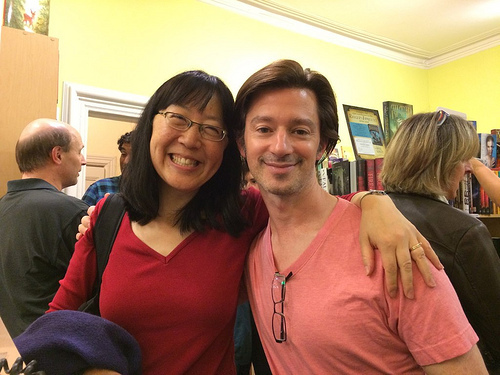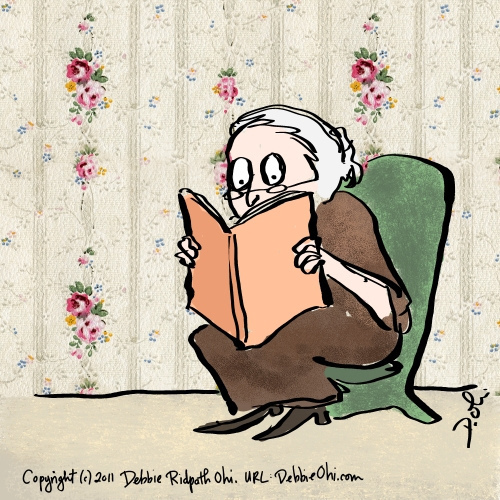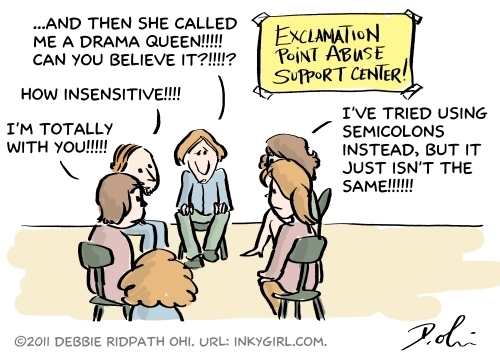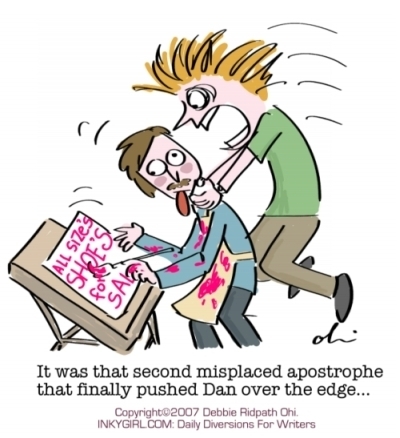Debbie Ridpath Ohi's Blog, page 89
October 7, 2013
2013 SCBWI-Montreal Conference Report (Part 1): crepes, Bookstore Bash readings, comfort zones...and my opening keynote (!!)
 Pin I designed for this year's conference, crafted by Alma Fullerton.
Pin I designed for this year's conference, crafted by Alma Fullerton.
I just got back from the SCBWI Canada East conference in Montreal. Huge thanks to Lizann Flatt, Alma Fullerton, Peggy Collins, Michelle Jodoin and Rachel Eugster for creating such a wonderful event! I've posted my photos on Flickr and on Facebook.
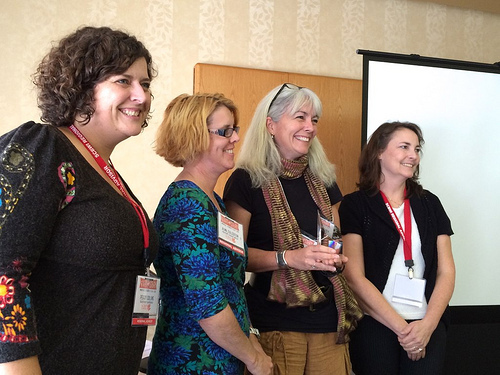 Peggy Collins, Alma Fullerton, Jennifer Lanthier (Crystal Kite recipient) and Lizann Flatt
Peggy Collins, Alma Fullerton, Jennifer Lanthier (Crystal Kite recipient) and Lizann Flatt
This was my first time attending a SCBWI regional conference, which was much smaller than the national conferences in LA and NYC. To those of you who find the national events somewhat overwhelming, I strongly encourage you to attend regional events like this one. The size made for a less intimidating atmosphere, with more opportunities to meet industry professionals in a quieter setting.
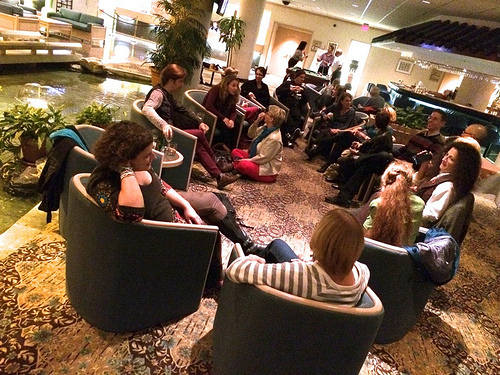 Hanging out by the koi pond on Saturday night. This casual gathering (open to all attendees) included Laurent Linn (Simon & Schuster), Linda Pratt (Wernick & Pratt), Bonnie Bader (Penguin) and Jill Santopolo (Penguin).
Hanging out by the koi pond on Saturday night. This casual gathering (open to all attendees) included Laurent Linn (Simon & Schuster), Linda Pratt (Wernick & Pratt), Bonnie Bader (Penguin) and Jill Santopolo (Penguin).
After I arrived on the Friday, I met up with some of the organizers and faculty at Creperie Chez Suzette in Old Montreal:
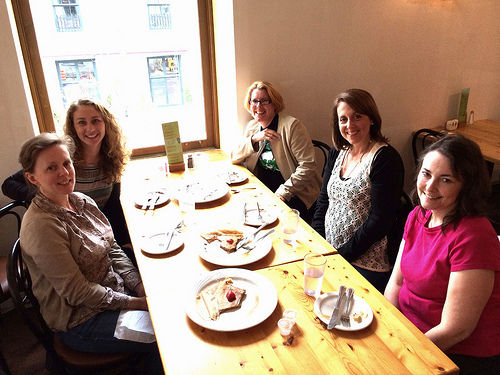 Linda Pratt (Wernick & Pratt agency), Jill Santopolo (Philomel/Penguin), Alma Fullerton, Bonnie Bader (Grosset & Dunlap, Price Stern Sloan/Penguin), Lizann Flatt
Linda Pratt (Wernick & Pratt agency), Jill Santopolo (Philomel/Penguin), Alma Fullerton, Bonnie Bader (Grosset & Dunlap, Price Stern Sloan/Penguin), Lizann Flatt
I helped them finish a decadent caramel-ly crepe (yummmm). My room was ready when I got back to the hotel, yay! I checked in, unpacked, and then headed downstairs to see who was around.
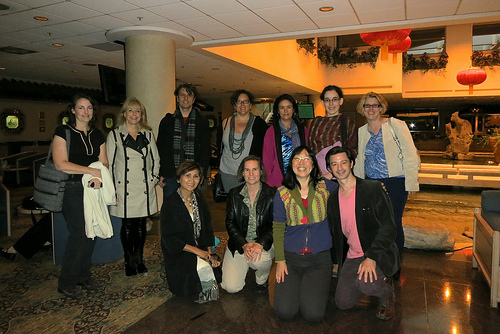 Top row, L to R: Lizann Flatt, Kelley Fairbank, Niall Eccles, Ellie Arscott, Caroline, Jasmine, Alma Fullerton. Bottom row, L to R: Alice Yen Yong, Robin Walton, me, Laurent Linn.
Top row, L to R: Lizann Flatt, Kelley Fairbank, Niall Eccles, Ellie Arscott, Caroline, Jasmine, Alma Fullerton. Bottom row, L to R: Alice Yen Yong, Robin Walton, me, Laurent Linn.
Some of us met in the lobby and introduced ourselves before having a fine dinner at a Chinese restaurant (Laurent Linn and I split a Magical Dancing Shrimp dish...ok, I can't recall the exact name) and then heading off to the Bookstore Book Bash.

SCBWI-Montreal conference attendees were invited (along with the public) to a book reading by SCBWI authors/illustrators at Babar-En-Ville, a children's bookstore in Montreal. I met Maya Byers, owner/buyer at the store, as well her son. Maya was already familiar with my sister and her books!

So enjoyed hearing readings from so many different types of children's and YA books, including authors Rachel Eugster, Jennifer Lanthier, Caroline Pignat, Urve Tamberg, Peggy Collins, Jill Santopolo (who is also an editor at Penguin), Alma Fullerton and Lizann Flatt.
Also great to meet Carol-Ann Hoyte in person at last...
as well as other familiar names/faces.
I felt a bit of pressure reading I'M BORED in front of my art director for the first time! But Laurent said I did fine:
Thanks to all who came out to the Bookstore Bash! It was a great way to start off the weekend.
The next morning, I woke up extra early to test out my tech set-up before my opening keynote. I wanted to make sure my slides worked with the projector ... and they did (*whew*). I had a brief brain spasm at one point during setup and forgot how to assign Keynote presentation to a different monitor, so woke up Jeff with a phonecall to ask him something he had already explained the day before. I do have a patient husband. :-)
 Registration table, manned by Ellie Arscott & Peggy Collins.
Registration table, manned by Ellie Arscott & Peggy Collins.
After the welcome and opening announcements, it was my turn! As some of you may know, I was nervous about my opening keynote. I've always avoided public speaking, mainly because I used to have a bad stammering problem when I was younger (it was a struggle even saying "hello" on the phone). Although I'm fine these days, it still crops up occasionally and especially when I get stressed or tired.
I started to say yes to public speaking invites, though, because I figure it's good for me and my career. I try to step out of my comfort zone on a regular basis, to do things that terrify me every once in a while, because it keeps me from getting too complacent.
 Giving my opening keynote at SCBWI-Montreal! Photo credit: Urve Tamberg.
Giving my opening keynote at SCBWI-Montreal! Photo credit: Urve Tamberg.
My sister, who is super-experienced at speaking in front of both grown-ups and young people, gave me some tips, and so did some of my Torkidlit friends. My husband helped me finetune my talk as well as providing tech support.
And guess what? Not only did my talk go well (according to later feedback), but after the initial few moments of sheer terror, I actually (*gasp) started HAVING FUN. I talked about my career path, what I've learned along the way, advice I wish I could give my younger self, and some tips on how to get the most out of the conference.
Here was an example of what NOT to do:

Above: one of the slide sequences I created for my keynote. J = Jill Santopolo and B = Bonnie Bader, the two editors on the SCBWI-Montreal faculty. :-)







October 3, 2013
I'm illustrating SEA-MONKEY AND BOB by Aaron Reynolds for Simon & Schuster BFYR!

I am delighted to announce that I'm illustrating SEA-MONKEY AND BOB, a new picture book by Aaron Reynolds (author of CREEPY CARROTS and the recently released CARNIVORES), scheduled for publication in Fall 2015.
Veryvery excited about this project for so many reasons, including:
1. I love Aaron's work! Check out his website for more info about his many wonderful book projects.
2. I've been soooo wanting to illustrate an underwater creature story.
3. I've had quite a history with Sea-Monkeys, and once had Sea-Monkeys named Lettuce and Abdul The Destroyer.
I'm so looking forward to working on this book. :-)







October 1, 2013
Work deadline organization: My new book deadline custom cork board
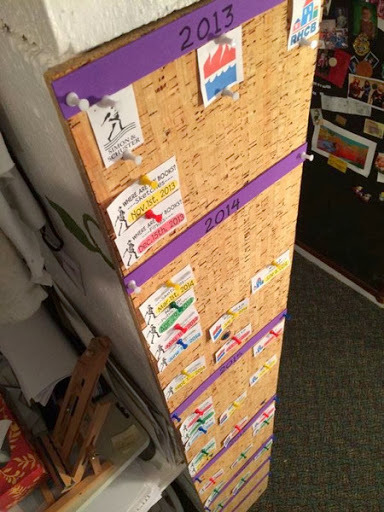
With multiple book projects coming up, I've been looking for a way of listing upcoming deadlines in such a way that I could visually scan everything at a glance from where I sit at my desk. I do have digital tools like CulturedCode's Things and Evernote to help me with day-to-day task organization and looking up project details, but I really wanted a way I could easily see an overview.
Reason I like to get an overall picture in one glance: It helps me feel more organized, more in control of what's going on. If I find myself in a quiet period (waiting for feedback, for example), I can be working ahead on another project. Before committing to other events or projects (whether personal or work-related), I can quickly scan my board and check feasibility.
I spent a lot of time research Gantt chart solutions, but found all of them either too expensive or too complicated. I knew that if it wasn't super-easy to use, I would end up abandoning the software after the "oo, this is so slick and cool" honeymoon period.
In the end, I opted for an old-fashioned physical solution.
The challenge: my basement office has very, very little free wall space. I started out with a paper chart that I taped onto one side of a supporting pillar. I had painted a vine on the surface of the pillar already, but didn't mind covering up my painting. This system was ok, but the paper kept tearing and shifting, so my husband volunteered to cut and install a custom cork board for me (he's a programmer/techtype but also loves building physical stuff as well).
I created a template in Photoshop for each deadline listings, using different colours for different types of project deadlines:
Light blue = manuscript deadline
Yellow = sketch deadlines
Red = final art deadline
Green = publication of the final book
Some issues I still have to work out:
- I'm finding that the deadlines listed in the book contracts get changed around. So do I list the contract deadlines or the modified deadlines? Or both? I'm opting for the latter, but I'd still like to be aware of the contract deadlines as well.
- Right now I'm working with three publishers. What happens when/if I start working with more? I'll probably end up shrinking the size of my listing template. Or maybe find a different place in my office for another cork board?
Advantage of having a physical project deadlines board:
In addition to other reasons listed above, it's super-easy to move listings around. I can also make quickie temporary changes by adding a small handwritten note that I can "formalize" later on in my Photoshop template.
Disadvantage of having a physical project deadlines board:
I can only use it in my office. The only way I can see it from my mobile devices is to take a photo, make that photo accessible, and then zoom in the see details.
Summary:
This solution works wonderfully for me right now.
p.s. If I could tell my younger self that I'd eventually need a system to help me keep all my book projects organized, I wouldn't have believed me.
p.p.s. I've blurred out a few of the projects because I'm not allowed to announce them publicly yet. Hopefully soon, though!







September 29, 2013
Quickie Poll Results: Strange Things That People Use As Bookmarks
Earlier in the weekend, I asked what you used as bookmarks in the last print book that you read. 42% said that you just used a regular bookmark. 9% said you fold back the corner of a page (GAH!!!). 6% said you didn't use any bookmark. The rest used irregular bookmarks (see comments below). I also asked people to list the most unusual item they've ever used as a bookmark.

Glad to see that I'm not the only one who has used my Kindle to mark my place in a print book. I do have a large collection of bookmarks, but more often I just grab whatever nearby object's handy to use to mark my place.

Here's a list of items that some of you said you've used as bookmarks in the past:
"Reading glasses (bonus: you also know where your reading glasses are). @amgamble"
"My wife used the dustjacket flap, which may be grounds for divorce. - @RonCharles"
"Candy wrapper. @ConnieBDowell"
"Another book, probably. Maybe that's not all that unusual. @jenhoward"
"My Kindle? True story. Or my reading glasses. I have also used clothing items. @janflora"
"A botched square from my string quilt project @krwhimsy"
"A Burger King straw, still in the wrapper. It was all I had on hand at the time. Still, CoffeeandKiwis on Twitter."
"Leaf I pulled off of a tree @MomDude56"
"An old photograph I found in a used book: three fierce-looking men standing in front of a Model T Ford."
"Another book! @rfarrenbarber"
"Leaf or twig while on the dock at the cottage @SuzanneDelRizzo"
"A sock @CMLasswell"
"Probably a hair tie - it was an emergency and the first thing that came to hand."
"(clean) tissue"
"A knitting pattern chart! Though I don't suppose that's actually 'unusual' when it's marking your place in a knitting book... @Knitronomicon"
"A pokemon card! @katefall"
"Anything that comes to hand: sticky notes, stick flags, tissues, napkins, old train tickets, receipts, photos, old Metrocards, paper money (usually just a one-dollar bill). I have plenty of real, purpose-built bookmarks, but they are never where I need them."
"I make my own by tearing reply cards into narrow strips."
"Reading in the car at kid's soccer practice, used the tow truck operator's business card that he left after last repair."
"I often use bits of paper my kids have doodled on. They make me smile. @jenhoward"
"I like to use old hotel key-cards (or similar - used gift cards, etc.). They're good and sturdy! (@JBD1)"
"Yes, I marked them all, which seems ridiculous, but I do them all and I did most of them to the recent book. I have tons of bookmarks, but I often fall asleep reading, so the book falls shut or I just grab a piece of paper in a hurry. And I have a book laying upside down and open beside me now. Note: I don't think I cornered the book I just finished, but had to check it out of residual guilt because that was a habit my mom always reprimanded me for as a child ("A tree died for that book!"). I did fold a bottom corner (of the laying open book--so bad!) to mark a quote I need to find later (guiltguiltguilt). @janflora"
"I used a letter from my girlfriend. It's still in my copy of No Plot? No Problem!. I'm CoffeeandKiwis on Twitter."
"Airplane boarding pass @MomDude56"
"I used one of my own promotional postcards..."
"One of those post-it sticky arrows."
"I usually use those "subscribe" postcards that fall out of magazines like the New Yorker. @annerallen"
"(My irregular bookmark was my chiropractor's business card). @dragonwrites"
"I made mini bookmarks from Moo mini cards to accompany promo materials. I always keep a few for myself ??@SuzanneDelRizzo"
"Don't fold the corner!! I used a glossy promotional card that was given to me by an author. @CMLasswell"
"Discarded backing paper from a sticker."
"I like The Last Line bookmarks that slip over a few pages - they stay in place and there's nothing sticking out to get caught and dislodged. Unfortunately, I don't think they're made any more... @Knitronomicon"
"Bookmark from the (indie!) bookstore where I purchased the book. @wisekaren"
"Kleenex"
--------------
Also see the list of other Inkygirl survey results.







September 28, 2013
Interview with Moira Allen, author and founder of Writing-World.com
Moira Allen is the editor of Writing-World.com, and has written nearly 400 articles, serving as a columnist and regular contributor for such publications as The Writer, Entrepreneur, Writer's Digest, and Byline.
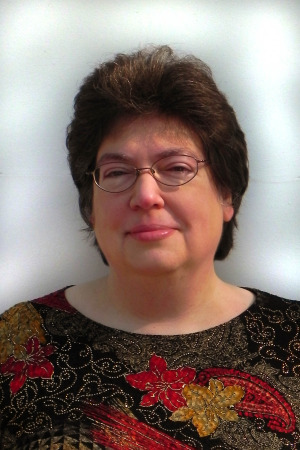 Those of you who have been following my projects from the very beginning will be familiar with Inkspot, one of the very first websites for writers. Moira initially began writing articles for my site and newsletter but I liked her work so much that I eventually recruited her for a senior editorial role. We worked together for years but didn't actually meet in person until after Inkspot was shut down (see Inkspot Epilogue).
Those of you who have been following my projects from the very beginning will be familiar with Inkspot, one of the very first websites for writers. Moira initially began writing articles for my site and newsletter but I liked her work so much that I eventually recruited her for a senior editorial role. We worked together for years but didn't actually meet in person until after Inkspot was shut down (see Inkspot Epilogue).
I was delighted when Moira launched Writing-World.com, which is now a comprehensive compilation of more than 650 excellent articles for freelance writers of all interests and every level of expertise, including resources for children's writers. The site also offers a free e-mail newsletter that includes publishing industry news, articles and contest info.
Moira is the author of eight books, including Starting Your Career as a Freelance Writer, The Writer's Guide to Queries, Pitches and Proposals, and Writing to Win: The Colossal Guide to Writing Contests. In addition to Writing-World.com, Allen hosts Mostly-Victorian.com, a growing archive of articles from Victorian periodicals, and The Pet Loss Support Page, a resource for grieving pet owners. She lives in Maryland with her husband and the obligatory writer's cat. She can be contacted at editors "at" writing-world.com.
Q. Could you please tell Inkygirl readers more about Writing-World.com?
I’ve been thinking about this question for several days, and realized that it’s not possible to talk about Writing-World.com without talking about Inkspot. I’d love to say that I had this fantastic “vision” for Writing-World.com, but the reality is that this site began as a continuation of YOUR vision.
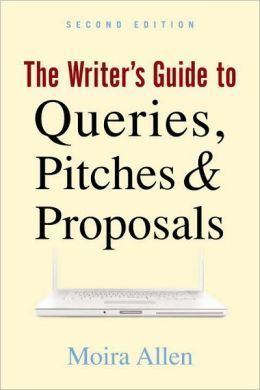 I don’t know if I ever told you exactly how it came about. But if you recall, toward the end of 2000, we knew that big changes were coming to Inkspot via its new owners. We assumed that the changes would take the form of laying off staff, and I assumed that my days with Inkspot were numbered. I’d loved working with Inkspot and being a part of building what was then surely the world’s largest and most popular site for writers. So I was wondering what I would do next.
I don’t know if I ever told you exactly how it came about. But if you recall, toward the end of 2000, we knew that big changes were coming to Inkspot via its new owners. We assumed that the changes would take the form of laying off staff, and I assumed that my days with Inkspot were numbered. I’d loved working with Inkspot and being a part of building what was then surely the world’s largest and most popular site for writers. So I was wondering what I would do next.
When I talked this over with my husband, he asked, “Who’s Number Two?” I thought about that, and thought that, at the time, there really wasn’t a site for writers that I would have considered a “close second” to Inkspot. There were a number of smaller, less ambitious sites, but Inkspot was certainly many lengths ahead of the rest of the field. And I thought, with the knowledge and connections I’d gained through Inkspot, I could quite probably come up with a site that would BE, at the least, Number Two for writers.
So as that year drew to a close I set about devising and designing Writing-World.com. I wanted it to be far more than just “Moira Allen’s many tips for writers” (my very first writing site was, in fact, “Tips for Writers”). I figured I would need advertisers, and I’d need to pay for articles, just as Inkspot did. I’m a firm believer that “you get what you pay for.” So many writing sites at that time couldn’t afford to actually pay for material, so they relied upon what they could get for free, and frankly, it showed.

 I had my plans ready by February 2001 – but we never imagined that, instead of just laying off staff, Inkspot would end up being shut down forever! So here I was, gearing up to be the “Number Two” writing site on the Web, and the Number One writing site suddenly was wiped of the electronic map! You, Debbie, gave Writing-World.com a huge boost by directing Inkspot’s bewildered traffic in my direction, and I was able to pump up the content of the site far more quickly than I’d ever expected by being able to take on a lot of the articles that had previously been posted on Inkspot.
I had my plans ready by February 2001 – but we never imagined that, instead of just laying off staff, Inkspot would end up being shut down forever! So here I was, gearing up to be the “Number Two” writing site on the Web, and the Number One writing site suddenly was wiped of the electronic map! You, Debbie, gave Writing-World.com a huge boost by directing Inkspot’s bewildered traffic in my direction, and I was able to pump up the content of the site far more quickly than I’d ever expected by being able to take on a lot of the articles that had previously been posted on Inkspot.
We planned to give the site time to break even – and were amazed that it turned profitable in its very first year. This has made it possible to go on as I began: By paying quality writers to produce quality material for the site.

 If there’s a driving vision for the site, it’s the idea of being a place that has something to offer EVERY writer. I didn’t want to be a site just for beginners, though we do have a huge “getting started” section for both nonfiction and fiction writers. Nor did I want to be a site just for more experienced writers. It can be dangerous to try to be “all things to all people,” so I envisioned the site as being a place where a writer could enter at just about any level of expertise, and then find tips and tools to advance further in their chosen direction. If you’ve never sold an article before, you can come in through the “getting started” section and learn what you need to know to launch your freelancing career. If you’ve been writing for awhile, you can pick up fresh tips in the “freelancing” section to help you expand into new markets and try things that you might not otherwise have thought of.
If there’s a driving vision for the site, it’s the idea of being a place that has something to offer EVERY writer. I didn’t want to be a site just for beginners, though we do have a huge “getting started” section for both nonfiction and fiction writers. Nor did I want to be a site just for more experienced writers. It can be dangerous to try to be “all things to all people,” so I envisioned the site as being a place where a writer could enter at just about any level of expertise, and then find tips and tools to advance further in their chosen direction. If you’ve never sold an article before, you can come in through the “getting started” section and learn what you need to know to launch your freelancing career. If you’ve been writing for awhile, you can pick up fresh tips in the “freelancing” section to help you expand into new markets and try things that you might not otherwise have thought of.
One of the things I’ve always considered terribly important for writers is to understand that writing isn’t just about creativity. If you’re hoping to get paid for your writing, then it’s vital to understand the writing BUSINESS. So I’ve worked hard to develop a strong section on issues of business, finance, tax planning, and rights and contracts issues.
Writing-World.com began as a “webzine,” and I think that continues to set us apart today in a world where, it seems, the new generation of web-surfers assumes that everything online is a “blog.” I like blogs, but there are many different ways to present information. A webzine format, to my mind, gives greater freedom for visitors to navigate amongst a variety of topics, moving easily not only from one page to the next, but also being able to easily find one’s way back to a particular section or menu. It’s also easier in this format to focus upon providing in-depth information rather than “nuggets” – we’re more interested in providing great articles than getting “feedback” and “comments.”
I have to admit, though, that I never imagined the site would grow as it has. Today, if my webstats are to be believed, we’re getting almost two million visitors every year. Even if half of those are robots, that’s an amazing figure.
The wonderful thing about the Internet is that it offers a chance to “pay it forward” in such a profound way. If a writer comes to us and comes away with information or inspiration that leads that writer to great things – to getting that novel published, to building a career in his or her dream field, to winning an award, to changing the world – that makes it all worthwhile, even if I never even hear about it. I tend to think writers have a greater capacity to change the world than almost anyone else – and I like to think that Writing-World.com is a part of that world-changing.
What are you working on now?
 Sometimes I feel like I’m working on so many things at once that I’m not even sure what I’m doing on a particular day! Somehow my career moved from “writing articles for magazines” to “managing a whole bunch of websites.” I actually got a call, once, from GoDaddy.com – granted, they wanted to upsell me something, but the guy on the phone was a little curious as to my list of domain names, because they didn’t seem to have anything in common!
Sometimes I feel like I’m working on so many things at once that I’m not even sure what I’m doing on a particular day! Somehow my career moved from “writing articles for magazines” to “managing a whole bunch of websites.” I actually got a call, once, from GoDaddy.com – granted, they wanted to upsell me something, but the guy on the phone was a little curious as to my list of domain names, because they didn’t seem to have anything in common!
 For example, I own Writing-World.com, Pet-Loss.net (the Pet Loss Support Page), TimeTravel-Britain.com, and Mostly-Victorian.com. I have a couple of domains that relate to my photography, and I also bought up a couple that, down the road, I thought I would be able to use with my novel-in-progress. (One relates to ghosts and one relates to castles.) Plus I manage a website for my sister, who is a stained glass artist, and for my husband, who is an Operations Research expert – so I can see why this poor guy at GoDaddy wasn’t seeing any obvious “pattern” in my domain names! (I have 13 domains at present!)
For example, I own Writing-World.com, Pet-Loss.net (the Pet Loss Support Page), TimeTravel-Britain.com, and Mostly-Victorian.com. I have a couple of domains that relate to my photography, and I also bought up a couple that, down the road, I thought I would be able to use with my novel-in-progress. (One relates to ghosts and one relates to castles.) Plus I manage a website for my sister, who is a stained glass artist, and for my husband, who is an Operations Research expert – so I can see why this poor guy at GoDaddy wasn’t seeing any obvious “pattern” in my domain names! (I have 13 domains at present!)
Right now, my big project is developing a line of Victorian-themed clip art. I fell in love with Victorian engravings and line art while we lived in England for about 15 months. Over there it’s easy to find inexpensive Victorian magazines in lovely old bookshops, so I amassed quite a collection of magazines like The Girl’s Own Paper, The Strand, Chatterbox, and more.
I’m working on converting the text of many of those publications to digital format and archiving them on my Mostly-Victorian.com website (stay tuned – I’m nearly ready to redesign and relaunch that site with a HUGE pile of Victoriana). But I realized that what really appealed to me in these magazines was the art. Don’t ask me why – but I also find that a lot of my “passions” go all the way back to childhood.
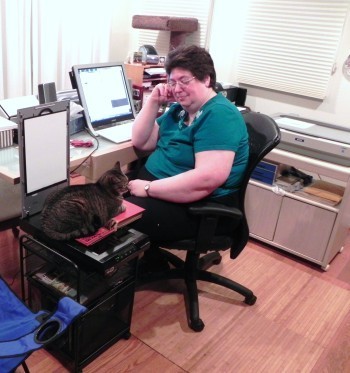 When I was a kid, my dad was a graphic artist, and sometimes he’d take me to the art supply store with him. He’d let me pick up a few things, and what drove me absolutely wild was the peel-and-stick sheets of Victorian page decorations and fancy Victorian fonts. (You have to remember the days BEFORE computers and desktop publishing, when, if you wanted a fancy heading font, you got a sheet with the font printed on transparent sticky plastic, and you cut out your letters with an Exacto knife and oh-so-carefully pasted them onto blueline layout paper.) So this is not a “new” thing – I guess it was just a rediscovered passion!
When I was a kid, my dad was a graphic artist, and sometimes he’d take me to the art supply store with him. He’d let me pick up a few things, and what drove me absolutely wild was the peel-and-stick sheets of Victorian page decorations and fancy Victorian fonts. (You have to remember the days BEFORE computers and desktop publishing, when, if you wanted a fancy heading font, you got a sheet with the font printed on transparent sticky plastic, and you cut out your letters with an Exacto knife and oh-so-carefully pasted them onto blueline layout paper.) So this is not a “new” thing – I guess it was just a rediscovered passion!
But as a result of buying up every tattered, ragged Victorian magazine I could afford in those LOVELY antiquarian bookshops, I ended up with a huge collection of art, and now I’m working on developing that into a line of clip art collections. I’ve started collecting “ephemera” too – Victorian scrapbooks, trade cards, greeting cards, and such. In my household I am known as The Mad Scanner.
Don’t ask me when this is actually going to come to fruition; I was hoping this spring, but now am having to put that date back a bit and hope for, maybe, early fall. There’s a LOT to be done.
In the writing realm, I’m working on getting back in the saddle and working on “the second first draft” of my romance novel. (This is the one where I’ve bought up domain names pertaining to castles and ghosts, enough said!) Facing the second draft has been intimidating; now, however, I’m thinking of it as a “second first draft” because it still means fixing a great many plot holes. With the issue of needing to be “perfect” removed, I think there’s a lot better chance that it’s going to happen!
Ironically we came up with this particular plot while living in England. We’d gone to Chichester for a holiday, and ended up stuck in our self-catering flat with the flu. It was pouring rain outside, most things hadn’t opened up for the tourist season yet, my husband was finally coming off his fever and mine was just beginning. I started thinking about a plot line that involved an American woman VISITING England, figuring, hey, that’s certainly in the “write about what you know!” ballpark! So she’s staying at this castle, and… Well, that’s all I’m going to say. Except it probably rains a lot.
(We did, by the way, eventually get back to Chichester, in time to see their absolutely fabulous flower show in the cathedral, so all’s well that ended well, AND it was sunny on that visit!)
Beyond that I am always trying to keep up with Writing-World.com – it’s amazing how challenging it is to come up with an editorial every two weeks. At the moment I can’t imagine how folks manage a regular blog (though I’m starting to lean in that direction).
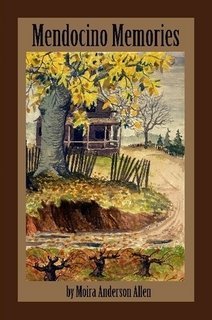 Another “really want to do that” project on my list is another personal memoir. I did one a few years ago on my childhood experiences in our Mendocino County farmhouse, in the back of the back of beyond, and that was just loads of fun. My mother was an avid photographer, so she left mounds of photos that I was able to use and write about. We also went traveling every summer, spending at least a month, and often longer, in Idaho, where my mother was born and raised. Those trips were something – this was, initially, in the days before recreational vehicles, and in any case we scorned anything but a tent. So we’d load up an entire month’s worth of supplies in, on, and around our station wagon and set forth on about a 1200-mile drive to get from California to Idaho, and then we’d camp I the most remote, out of the way, amenity-free places they could find. (By amenity-free, I mean that the places they picked made campsites with privies look positively luxurious.) Eventually, these trips were down to us “girls” – my mother, my sister, and me – and two large dogs. There are loads of stories that I want to tell, and, again, thankfully, I have loads of photos to illustrate them with (including my very first fish…).
Another “really want to do that” project on my list is another personal memoir. I did one a few years ago on my childhood experiences in our Mendocino County farmhouse, in the back of the back of beyond, and that was just loads of fun. My mother was an avid photographer, so she left mounds of photos that I was able to use and write about. We also went traveling every summer, spending at least a month, and often longer, in Idaho, where my mother was born and raised. Those trips were something – this was, initially, in the days before recreational vehicles, and in any case we scorned anything but a tent. So we’d load up an entire month’s worth of supplies in, on, and around our station wagon and set forth on about a 1200-mile drive to get from California to Idaho, and then we’d camp I the most remote, out of the way, amenity-free places they could find. (By amenity-free, I mean that the places they picked made campsites with privies look positively luxurious.) Eventually, these trips were down to us “girls” – my mother, my sister, and me – and two large dogs. There are loads of stories that I want to tell, and, again, thankfully, I have loads of photos to illustrate them with (including my very first fish…).
And then, let’s see, I’m about to help my sister develop a stained glass pattern book and try to get her launched in publishing and selling pattern books. My husband is considering rewriting, or writing a second edition of, his very technical book, so I’ll undoubtedly be a part of that. And I’ve also just taken up weaving; I’m still waiting for my loom to arrive, but I’m going through weaving magazines and books and thinking, “Ooh, I want to do that; Ooh, I’ve got to try that pattern; Ooh, I love those colors…” So somehow (and I’ve been bad about this) I need to make sure I make time for crafts and just having FUN.
Q. What on piece of advice do you have for aspiring writers?
[Note from Debbie: Moira ended up writing a longer post in answer to this question which she ended up posting in her Writing World newsletter. Thanks to Moira for putting so much thought into her reply!]
Not for Beginners Only...
Recently my friend Debbie Ridpath Ohi asked if I would do an interview for her. After we'd wrapped it up she sent me a final question: "What one piece of advice do you have for aspiring freelance writers?"
It has taken me months to come up with an answer. The trick, of course, is that word "ONE." I have loads of advice; I have an entire website full of advice. But... ONE piece? And, preferably, one piece that does not simply repeat what beginners have heard a thousand times before? ("Learn your craft; always strive to improve; understand the trade!")
So I thought I'd turn the question around, and ask whether there is a specific challenge facing new writers today that was not an issue back in the semi-dark ages when I got started. And it seems to me that there is: Social Media.
Most articles on the topic of "writers" and "social media" extol the benefits writers can reap from exploiting this new realm of communication. But for beginning writers, I believe social media offers a downside. It has the potential to reinforce a view that afflicts many beginners (and many not-so-beginners): The view that writing is "all about ME."
 When we start out as writers, quite often, we are terribly full of ourselves. Often, we are embarking upon a journey of self-exploration. We are bursting with thoughts, ideas, memories, and experiences that we consider dazzling and enthralling simply because they are ours. Either we imagine that our ideas are so unique and amazing that the world will be stunned by their brilliance, or we suppose that we have such a grasp of the plight of "everyman" that the world cannot help but see itself reflected in our prose. Consequently, it is very easy for our writing to become full of, well, US.
When we start out as writers, quite often, we are terribly full of ourselves. Often, we are embarking upon a journey of self-exploration. We are bursting with thoughts, ideas, memories, and experiences that we consider dazzling and enthralling simply because they are ours. Either we imagine that our ideas are so unique and amazing that the world will be stunned by their brilliance, or we suppose that we have such a grasp of the plight of "everyman" that the world cannot help but see itself reflected in our prose. Consequently, it is very easy for our writing to become full of, well, US.
In those ancient days when writers hunched over typewriters and made carbon copies, this wasn't much of a problem. One sent one's brilliant, me-focused poem, story or article to an editor, held one's breath for roughly six weeks, and got the inevitable form rejection. Successful writers were those who eventually figured out that something wasn't working, took a look around at what WAS getting published, and adapted accordingly. And while this system was certainly a bit rough on beginners, it worked -- because in those bad old days, the only writing that one could find as an "example" to guide one's path was writing that was good enough to be PAID FOR. Whether you turned to books, magazines, or newspapers, the only "published media" you could find was work that readers considered good enough to PAY to read -- and that editors, consequently, considered good enough to pay to acquire.
Naturally, this led to plenty of grumbling amongst new and not-so-new writers who WEREN'T getting paid -- or published. Editors and publishers were widely accused of being hostile gatekeepers, turning away wondrous works by the score in their crass pursuit of "marketable" material. If only there were another way to get one's work to the world, why, then, surely the world would beat a path to one's door...
Fast forward to the world in which that dream has become a reality -- and the situation it creates for writers today. The "me-focused" affliction still haunts us, but when we look around at what is "out there," what do we see? We see a world of "ME." Now, granted, there is much that is admirable in the world of social media. But for every well written and informative blog, there are a thousand that have nothing worthwhile to say, and that say it at great length. For every inspirational Facebook page, there are thousands of people posting what they had for breakfast. For every meaningful tweet... Well, you get the idea.
For a new writer who is exploring self-expression, it has become far too easy to assume that the emphasis is on the word "self." After all, if so many people are sharing what they had for breakfast, surely this must mean that somewhere, there's an audience that cares what YOU had for breakfast, so why not tell them?
Now, let me be clear: I am not saying that new writers do NOT have brilliant ideas to share. In fact, a great many DO. The problem lies in determining how to separate one's brilliant ideas from one's sense of being the person who comes up with those ideas. It lies in determining the balance between sharing one's self and sharing what lies WITHIN one's self. How do you get what is within you out into the world, while simultaneously getting yourself out of what is within you?
If that sounded convoluted, allow me one more old-fashioned example. Many years ago, some family friends (call them Mr. and Mrs. W.) returned from a trip to Europe. This was before home computers, the Internet, or Facebook -- so to share such experiences, people invited other people to their homes, turned out the lights, and gave SLIDE SHOWS. (This was legal. You could actually do this to someone without being locked up on charges of cruelty and abuse.)
So Mr. W. got behind the slide projector, and we settled in our chairs to watch slide after slide of the famous sights of Europe. And every slide, whether of a castle or a cathedral or a village street, had one thing in common: It also included Mrs. W. Every single one.
This is the problem with me-focused writing. A writer wants to share something memorable, meaningful, beautiful, inspiring, or simply useful -- but, inspired by the me-focus of social media, also wants to share that "this is me sharing it with you." Instead of looking at the beautiful thing you want to show me, I end up looking at YOU showing me the beautiful thing.
So if there is ONE piece of advice I would offer new writers, it is this: Get out of the way. Forget about followers and friends and "likes" and re-tweets. What is inside you is bigger than "you." The more you cause your readers' attention to focus on YOU, the more you risk distracting them from the important and wonderful things you actually have to say.
Instead, look at the media that surrounds you from an old-fashioned perspective. Ask yourself if you would pay to read a particular blog, or Facebook page, or tweet. If the answer is no, then don't use it as an inspiration for the type of writing that you would like to get paid for.
Don't get me wrong -- I'm not suggesting that you avoid social media, either as a writer or a reader. But it is not the model to turn to if you want to learn how to write publishable (i.e., "saleable") material. If you yearn to craft stories, poetry, novels or nonfiction, and get paid for the privilege, learn that craft from those works that you'd be willing to pay for the privilege of reading. Social media gives you a wonderful way to talk to your audience -- but great writing is what gives you a chance to build one.
-- Moira Allen, Writing-World.com editor
-------------
Where to find out more about Moira Allen:
5 Steps To Self-Publishing Success
Interview with non-fiction author, Moira Allen - by Penny Lockwood Ehrenkranz
20 Questions Answered By Moira Allen Of Writing-World.com - WOW! Women On Writing 2007







September 27, 2013
Quickie Poll Results: Ending Peekers and Emoticon Parentheses
Last weekend, I asked on Twitter how many people sometimes peeked at the ending while they were reading a book. 67% of you said YES. Shame on you cheaters! (Ok, I secretly admit that I've done it once. BUT ONLY ONCE.)
Another quickie survey question I asked a while back was about the use of emoticons and parentheses. My question: "If you were going to add a prenthesis to an emoticon at the end of a sentence, which would you use?
The choices:
A) Squirrels are evil and taking over my backyard (and the world :)
B) Squirrels are evil and taking over my backyard (and the word :))
A whopping 93% of you chose (B).
I'm with the majority, if you're curious.
Thanks to all who participated!
-----------
You can also see other current and past surveys in the Inkygirl Survey Archives.







September 25, 2013
Interview: Cassandra Morris on creating audiobooks and the narration of I'M BORED

A while back I mentioned how much I loved the voice narration on the enhanced ebook version of I'M BORED. Voice actor Cassandra Morris has not only done narration work for audiobooks but also for anime and videogames, plus she is also a writer and editor.
Cassandra has kindly agreed to answer a few questions about the process of recording an audiobook, as well as share some tips for aspiring young voice actors.
You can hear a sample of Cassandra's narration here:
You can get the enhanced ebook version of I'M BORED on iTunes.
Q. How did you become the narrator for the enhanced ebook version for I'M BORED?
 Cassandra with Kyubey, one of her characters.I've always loved reading. I was the kid in class who would read a book under their desk, totally oblivious to everything that was going on around them. I started doing community theater and taking dance lessons in Connecticut at age 8, and started acting professionally in New York City when I was 14. I did a lot of commercials and some TV and film, but where I really shined was voiceover work. Fast forward to 2004, when my agent sent me an audition to narrate the Young Adult novel “Dear Zoe,” by Philip Beard. It was my first audition for an audiobook. I fell in the love with the story, I really, really wanted to get the part, and it showed during my audition. I ended up booking the part! And that started my career as an audiobook narrator.
Cassandra with Kyubey, one of her characters.I've always loved reading. I was the kid in class who would read a book under their desk, totally oblivious to everything that was going on around them. I started doing community theater and taking dance lessons in Connecticut at age 8, and started acting professionally in New York City when I was 14. I did a lot of commercials and some TV and film, but where I really shined was voiceover work. Fast forward to 2004, when my agent sent me an audition to narrate the Young Adult novel “Dear Zoe,” by Philip Beard. It was my first audition for an audiobook. I fell in the love with the story, I really, really wanted to get the part, and it showed during my audition. I ended up booking the part! And that started my career as an audiobook narrator.
The producer of that book really liked my work, and he hired me to narrate another young adult novel. Then he gave my name to some other producers, and they started bringing me in for auditions to narrate books they were working on. I also started to do a lot of networking (trying to meet as many people as possible in the audiobook industry), because I discovered that this was something I really loved to do. I wanted to narrate more, and more, and more! I still do. Audiobooks combine two of my favorite things- reading and acting, so it's the perfect fit for me.
 Over the past two years or so, I've been narrating Simon & Schuster children's books regularly. They're some of my favorite books to work on! They're funny, beautifully illustrated, and it takes me back to my childhood, when my dad used to read to me before bed. I've narrated about 50 children's titles for them so far, which they've turned into enhanced eBooks.
Over the past two years or so, I've been narrating Simon & Schuster children's books regularly. They're some of my favorite books to work on! They're funny, beautifully illustrated, and it takes me back to my childhood, when my dad used to read to me before bed. I've narrated about 50 children's titles for them so far, which they've turned into enhanced eBooks.

Q. What was the process like?
The producer will send over PDF versions of the books- we call them “scripts,” even though it's basically the entire book, illustrations and all!- a few days ahead of time. I'll read them all, familiarize myself with the story (paying special attention to places where there should be pauses, deciding how to handle repetitive lines, what to do for the story climaxes, etc.) and come up with any character voices I'll want to do. I'll also check the script for any words or names I don't know how to pronounce. It's pretty rare to come across a word I've never seen before in a kid's book, but on a few occasions I've had dinosaur names or names out of an ancient myth that I didn't know. I'll look up the word, and contact the producer for help with any names.
 With audiobook producer Paul Gagne at the Audies (the "Oscars Of Audiobooks")Then, I show up at the recording studio for my session! The recording engineer sets up the microphone and has me do a test read of a few pages to set the recording levels and make sure everything sounds perfect. I'm in Los Angeles, but Robert Kessler, the producer/director, is in New York, so he's patched in via phone line, and I can hear him in my headphones. Then, I start reading!
With audiobook producer Paul Gagne at the Audies (the "Oscars Of Audiobooks")Then, I show up at the recording studio for my session! The recording engineer sets up the microphone and has me do a test read of a few pages to set the recording levels and make sure everything sounds perfect. I'm in Los Angeles, but Robert Kessler, the producer/director, is in New York, so he's patched in via phone line, and I can hear him in my headphones. Then, I start reading!
We used to record off paper scripts, or even the actual bound book, but these days I record off of my iPad.
When I first started recording the Simon & Schuster kids' books, the director gave me a LOT of direction, and we would spend about an hour recording each book. I'd read the book several times, sometimes do certain pages or lines over and over, to get the cadence and delivery just right.
But like anything, the more you do it, the better you get. I know exactly what Robert is looking for, and he knows what to say to get the best performance out of me. So now we'll spend about a half hour on each book. I'll usually read each page twice, and sometimes we'll spend more time on a certain part of the book (usually during a really important turn, or the ending) to make sure the story is really brought to life.
Narrating children's books is very different from narrating novels. For novels, I'll usually do one take, and that's it. With kid's books, because they're so much shorter, I can spend a lot of time on each page and even stop and listen back if I want to hear something again.
 At a signing/promo event for the anime series "Madoka Magica."
At a signing/promo event for the anime series "Madoka Magica."
Q. Any advice for young people who aspire to become a voice actor?
Start acting and performing wherever you can! Audition for your school plays, do community theater, join an improv comedy group for kids.., take advantage of any acting opportunity in your area. Go to theater camp. Get as much acting experience as you can, get comfortable performing on stage, and build up your resume.
Above: Cassandra answers young people's questions about favorite characters at Kumoricon 2013.
Narrating an audiobook for one day is similar to performing back-to-back one-person stage shows, it takes a lot of stamina and you have to keep your performance fresh and engaging. Stage acting will help you prepare for that.
Also, do a lot of research. If you want to do animation, watch a lot of current cartoons. If you want to be an audiobook narrator, listen to audiobooks.
Above: Cassandra's impromptu interview about her work in the Pretty Little Liars audiobooks.
Q. Any current or upcoming projects and events you're especially excited about?
Yes! I play Leafa in Sword Art Online, which is airing right now on Cartoon Network during their Toonami block. I'm the voice of a Disney toy and part of their Palace Pets App as Berry, Snow White's bunny. And as for the audiobooks- I have some great ones that came out this year! If you like comedy, listen to “My Brother is a Big Fat Liar” by James Patterson. If you like adventure, check out the Cronus Chronicles trilogy by Anne Ursu. And if you're looking for another enhanced ebook, I loved narrating “A Very Fuddles Christmas” by Frans Vischer- it's an adorable story about an overindulged cat!
Q. Where can people find out more about you and your work online?
My official website is www.cassandraleemorris.com. I'm also on Twitter (@socassandra), Facebook (facebook.com/ilovecassandralee), and in my spare time I run a style blog with my friend called Style Smoothie (www.stylesmoothie.com). Let's be friends!
You can get the enhanced ebook version of I'M BORED on iTunes.
Related resources:
Wikipedia entry: Cassandra Morris
------
For more interviews, see my Inkygirl Interview Archive.







September 24, 2013
Happy National Punctuation Day!
Sept. 22-28, 2013 is Banned Books Week

Banned Books Week is the national book community's annual celebration of the freedom of read. The event was launched in 1982 in response to the surge in number of challenges to books in schools, libraries and bookstores. You can find a list of the 10 most challenged titles of 2012 on the Banned Books Week website.
My friend Cheryl Rainfield, author of challenged book SCARS and the upcoming STAINED wrote a beautiful poem about the sadness of banned books.
On Twitter, follow the #bannedbooksweek hashtag for related tweets.
Also see the Banned Books Week website for more info about how the community is celebrating the freedom to read, and what you can do to help.







September 23, 2013
Interview: Lisa Dalrymple and Suzanne Del Rizzo on the making of SKINK ON THE BRINK (Fitzhenry & Whiteside)

Title: SKINK ON THE BRINK
Author: Lisa Dalrymple - Illustrator: Suzanne Del Rizzo
Publisher: Fitzhenry & Whiteside - June 2013
I first heard about Skink On The Brink at a CANSCAIP meeting. Not only was the title intriguing, but I love the inspiring publication success story (details below). Lisa and Suzanne are popular children's book presenters; their activity session at Toronto's Word On The Street this past weekend drew over 100 young people! Lisa and Suzanne were kind enough to be interviewed for Inkygirl, and both give a TON of valuable info and insights into their process.
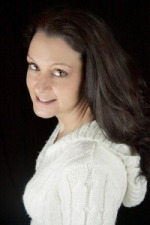 Lisa Dalrymple loves to travel and has lived in such countries as South Korea, Thailand and Scotland. She now lives with her husband and their three children in Fergus, Ontario. Her story, Skink on the Brink, won The Writers’ Union of Canada’s Writing for Children Competition in 2011 and is now a picture book illustrated by Suzanne Del Rizzo. Lisa is also the author of If It’s No Trouble… A Big Polar Bear and its sequel, Bubbly Troubly Polar Bear, coming in October 2013.
Lisa Dalrymple loves to travel and has lived in such countries as South Korea, Thailand and Scotland. She now lives with her husband and their three children in Fergus, Ontario. Her story, Skink on the Brink, won The Writers’ Union of Canada’s Writing for Children Competition in 2011 and is now a picture book illustrated by Suzanne Del Rizzo. Lisa is also the author of If It’s No Trouble… A Big Polar Bear and its sequel, Bubbly Troubly Polar Bear, coming in October 2013.
Where to find Lisa online: Website - Facebook
 Suzanne Del Rizzo loves the squish of plasticine between her fingers. Her illustrations appear in Skink on the Brink (Fitzhenry & Whiteside Spring 2013), written by Lisa Dalrymple. Her cover illustrations appear in the YA novel The Ehrich Wiesz Chronicles: Demon Gate ( Fitzhenry & Whiteside, Fall 2013) written by Marty Chan. She lives in Oakville Ontario with her husband and four children.
Suzanne Del Rizzo loves the squish of plasticine between her fingers. Her illustrations appear in Skink on the Brink (Fitzhenry & Whiteside Spring 2013), written by Lisa Dalrymple. Her cover illustrations appear in the YA novel The Ehrich Wiesz Chronicles: Demon Gate ( Fitzhenry & Whiteside, Fall 2013) written by Marty Chan. She lives in Oakville Ontario with her husband and four children.
Where to find Suzanne online: Website - Twitter - Facebook (personal) - Facebook (professional)
About SKINK ON THE BRINK:
Stewie is a very special skink — he has a beautiful blue tail which gives him a superpower against his enemies. Stewie loves singing his songs and rhymes as he dashes around his home. But as he grows up his beautiful blue tail starts to turn grey — he can't call himself Stewie the Blue anymore! And without his rhymes, his home by the pond doesn't feel as special either. A new Tell-Me-More Storybook about self-esteem, change, and growing up. Includes non-fiction back matter with bonus information and activities.
See the Fitzhenry & Whiteside SKINK ON THE BRINK page for supplemental materials created by Lisa and Suzanne, including coloring pages, activity pages, word searches, and more.
For lots of photos of Suzanne's amazing plasticine-illustration process, read further down in the interview.
 A few of Suzanne's plasticine carving tools. Read further for lots of photos of how she created the amazing illustrations in SKINK.
A few of Suzanne's plasticine carving tools. Read further for lots of photos of how she created the amazing illustrations in SKINK.
Q. What was your publication process for SKINK ON THE BRINK?
Lisa:
I actually can’t remember when I first started researching and writing the manuscript, but I think it was sometime around 2008. (It usually takes a couple of years for me to develop and craft a picture book story until it is finally submission ready.) During this time, I was also working on other books and I was trying to learn the ropes of the publishing industry by getting out, meeting other writers and professionals, and attending trade shows, festivals, etc.
 Christie Harkin, editor at Fitzhenry & Whiteside. Photo from Cynsations interview.In September 2010, I went to Word on the Street in Toronto. I remember that it was first thing in the morning that I saw Christie Harkin, the kids’ books editor at Fitzhenry & Whiteside, getting their booth ready for the day. I knew I wanted to talk to Christie, to find out what she was looking for in a manuscript and to establish a personal connection. However, first I had to walk around for a while to try to summon up the nerve. When I finally did, it was the end of the day and Christie was packing up her supplies to go home! She told me that she was developing a line of “Tell Me More” storybooks. In these books, while the story is, of course, the most important element, there’s also an additional educational component that can be more fully explored in the non-fiction back matter. We both agreed that Skink on the Brink might be a good fit for this line and that I should send it to her.
Christie Harkin, editor at Fitzhenry & Whiteside. Photo from Cynsations interview.In September 2010, I went to Word on the Street in Toronto. I remember that it was first thing in the morning that I saw Christie Harkin, the kids’ books editor at Fitzhenry & Whiteside, getting their booth ready for the day. I knew I wanted to talk to Christie, to find out what she was looking for in a manuscript and to establish a personal connection. However, first I had to walk around for a while to try to summon up the nerve. When I finally did, it was the end of the day and Christie was packing up her supplies to go home! She told me that she was developing a line of “Tell Me More” storybooks. In these books, while the story is, of course, the most important element, there’s also an additional educational component that can be more fully explored in the non-fiction back matter. We both agreed that Skink on the Brink might be a good fit for this line and that I should send it to her.
 Suzanne and Lisa do a signing with Michael Martchenko & Loris Lesynski at Toronto's Word On The Street
Suzanne and Lisa do a signing with Michael Martchenko & Loris Lesynski at Toronto's Word On The Street
There was a long period where I heard nothing, but I was getting used to no response if an editor really wasn’t interested. By the time February 2011 rolled around, I had completely given up. I went with a group of friends to the OLA Superconference in February and some of them stopped by the Fitzhenry & Whiteside booth to say ‘hi’ to Christie. When she noticed my nametag, she said, “Hey! You’re the skink lady!” I’d never been so excited to think that she remembered me and my manuscript. We had a “pre-editorial” discussion right there and I went home to create yet another draft of the book I’d now been working on for three years.
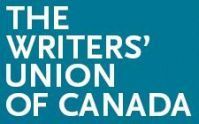 When April 2011 rolled around and neither of the books I had under consideration with two separate houses had yet acquired that elusive “yes,” I submitted them both to the Writing for Children competition hosted by The Writers’ Union of Canada. This competition receives between 600-800 entries each year and I submitted every year so, of course, I had no real expectation that I would win.
When April 2011 rolled around and neither of the books I had under consideration with two separate houses had yet acquired that elusive “yes,” I submitted them both to the Writing for Children competition hosted by The Writers’ Union of Canada. This competition receives between 600-800 entries each year and I submitted every year so, of course, I had no real expectation that I would win.
But then there was a day, the same day that I heard from Tuckamore Press that they were ready to send me a contract for my book If It’s No Trouble… A Big Polar Bear, when the phone rang and Nancy MacLeod informed me that Skink on the Brink had won the competition – and that I was sworn to secrecy for almost a week! By this point, Christie and I had a friendly relationship and I think it may have been my post on Facebook, “This is one of the most exciting days of my life,” that prompted her to get in on the excitement and send me my first official book contract!
 Suzanne adding detail to one of her illustration elements. Wow.
Suzanne adding detail to one of her illustration elements. Wow.
In October 2011, we signed the contract and Christie let me know that they were considering Suzanne Del Rizzo to illustrate the book. She sent me a few samples of Suzanne’s work. Of course, I was thrilled! Suzanne’s plasticine artwork is beyond anything I would have imagined for Stewie and his story and I was so excited to see it finally start coming to life.
In January 2012, Christie and I got started on the ‘first round’ of edits, which actually became the ‘never-ending round’ of edits as we kept passing the manuscript back and forth, trying to get some of the rough spots ‘just right’ so that Suzanne could get started.

And then the real fun began. I was so excited that Suzanne would consult with me about the illustrations. Her artwork was fabulous and she wanted to check in with me from a research perspective. We both wanted to make sure that we were using our combined knowledge to make sure that the book was as biologically accurate as possible.

Once the artwork was done, in January 2013, I received the ‘final round’ of edits from Christie and the book went to the printer. Then, in May, Suzanne and I were able to drop by the Fitzhenry & Whiteside office to finally hold the finished book in our hands!

Q. What was your writing/illustration process for SKINK ON THE BRINK?
Lisa:
I wish I could say I have a process that indicated some sort of routine but, working from home for the past few years with small kids around, any routine has been pretty hard to establish. I’m hoping this will improve when my youngest daughter starts school fulltime this year because I know how important it is to have that dedicated writing time. 98% of writing is pure hard work – just keeping that butt in your chair and working, preferably with few to no interruptions! Sure, there’s that other 2% of writing that’s genius inspiration, where the brilliant ideas come to you (usually in the shower) and you hop out, words already flying from your fingertips. That kind of writing can be done almost anytime, anywhere (although I would recommend getting out of the shower first.) But the other 98% is very difficult to do when there are so many demanding distractions of family life and when we all know how tempting it is to give in to distraction in the first place.
At the same time, my kids make huge contribution to my writing process. Getting their input and ideas, as I’m crafting a story is an invaluable part of the process for me. I can’t tell you how many years we’ve spent out in the wilderness on family camping trips, pretending to be skinks and shouting things like “I’m Stewie the Blue” over the pond – and how informative and inspiring it is to see how kids engage with your story when it’s still all coming together in your mind.
Suzanne:
My process for this book began with lots of research. I must admit, I’d never heard of a skink before reading Lisa’s manuscript, so I had some homework to do before I even put pencil to paper. I researched all I could online and from books, and took photos at my cottage (which falls within the geographical region of the Common Five-Lined Skink’s habitat) to create a massive photo reference file:


Lisa also provided me with some great shots she had taken while at The Pinery Park where she had seen a Common Five-Lined skink up close. Stewie the skink would be undergoing both physical growth and coloration changes throughout the story, and because this was also a Tell-Me-More story book with accompanying cross-curricular back matter; I wanted to ensure I was maintaining as much biological accuracy as possible.

I envisioned having lots of secondary animals and vegetation to make Stewie’s habitat rich and authentic, so I also needed to familiarize myself with the various animals and plant life that co-exist in his habitat. I then created some sample art for Christie to show at the sales meeting, and after landing the contract, I began thumbnail sketches.
Christie encouraged Lisa and I to get in touch and bounce ideas around. It isn’t always standard for authors and illustrators to discuss a project, but in this case, I think it really helped us achieve something special with this book, it was a fantastic collaboration. It even led to some hilarious “oops” moments...like the time when I made a minor flub and put a moose in one illustration... moose don’t extend quite this far south- oops. Luckily Lisa caught it and it was easily changed to a white-tailed deer. If you look closely on my full- sized sketch:

...you can see the moose, yet in the final plasticine illustration it has been changed to a white-tailed deer:

Once thumbnail sketches were approved I worked up full-sized tight pencil sketches:

Because I work in plasticine, I prefer to create very detailed, tight pencil drawings to show my editor, and ideally make changes at this phase of the project. Each plasticine illustration can take from 20-40+ hours to create, depending on its size and complexity, so it’s much easier to erase a few pencil strokes at this point then to peel off/redo the plasticine final art.
My illustrations are essentially low relief sculptures created in plasticine(modelling clay) and pressed onto illustration board. The final plasticine art is then professionally photographed:

Before I started any final art I premixed the colours, after some initial colour studies, to create a colour chart:

I hang this next to my sketch for quick reference. Then I made up large amounts of my colours so I’d be able to maintain consistency throughout the illustrations. This type of chart comes in handy if I run out of a colour and need to make more. To begin each illustration, I’d smear on plasticine in a thin layer to create the background, then gradually build up and add on, then move onto foreground objects as I go:


(From Debbie: click here for a close-up look at some of the detail in the final illustration)
One of my favorite parts of any illustration is adding the final textures and details to really bring life to the piece. I use a variety of clay sculpting tools but often times I end up using my good ol’ favorites-a large safety pin, toothbrush, toothpick and my fingers. Sometimes I even make my own tools. For Stewie the skink, I made a selection of polymer clay tools that make impressions of reptile scales:

then I used an acrylic gloss to make him glisten.
For intricate parts, I sometimes worked on top of a Ziploc bag that I’d place directly over top of my sketch:


(Note from Debbie: Click here to see details in a bigger version of the woodpecker)
Then I could check to ensure that my sculpted objects were the correct size- plasticine has a tendency to spread and flatten as you work with it, which can be frustrating. So I kept a bowl beside me for my “rejects”...and believe me there were plenty. Faces are especially tricky to get just right. But that’s the great thing about plasticine- it never hardens, so you can just peel off the offensive bits and smoosh ‘em, and start afresh. My kids like to raid the reject bowl (as they call it) and put these bits to use in their own creations.

Having a little kiddo sitting next to me on the floor, working on their own plasticine is one of the best perks about having my art studio in my home. Kids are also the best source of inspiration.

Q. What advice do you have for aspiring children's book writers and illustrators?
Lisa: There is so much important advice out there given by far more experienced writers than me – but you’re not going to hear any of it if you’re sitting in your house staring at a cursor on a screen...
Suzanne: ...or working away in your art studio. And I’m even more “green”, LOL but I am always happy to share what I have found helpful on my pursuit to publication.
Lisa: Get out there and meet other writers and creators. The camaraderie and support of a network of peers is invaluable – for information sharing, providing a shoulder to cry on (or a glass to clink with), for forming critique groups and for gaining access to all that wonderful advice.
Suzanne: Yes, you said it Lisa! We creative types tend to be an introverted lot, but it’s so important to put yourself out there and meet others, connect, share ideas and soak up advice from more seasoned author/illustrators. I have found this community of author/illustrators, both online and in person, to be extremely supportive and encouraging
Lisa: In Canada, some good places to start are organizations for children’s writers such as CANSCAIP and the Canadian Children’s Book Centre (CCBC). Internationally, look into the Society of Children’s Book Writers and Illustrators (SCBWI). Any festivals, trade shows or signings in your area that have anything to do with books can also be useful places to connect with other writers or industry professionals.
 Suzanne and Lisa with their editor Christie Harkin (in red shirt) and friends Jan Dolby & Joyce Grant at Toronto's Word On The Street
Suzanne and Lisa with their editor Christie Harkin (in red shirt) and friends Jan Dolby & Joyce Grant at Toronto's Word On The Street
Suzanne: The thought of attending a large conference might be utterly terrifying if you are just starting out, so start small. Check out the monthly CANSCAIP meetings, or go to Word on The Street and mingle at your pace, or hop online and get to know the Twitter and Facebook community of illustrators and kidlit writers. I must admit to having a bad case of “imposter syndrome” when I first made the career switch from working in a science research lab, after all I didn’t have an art degree. Could I make a go of it as children’s book illustrator? I decided to be brave and just go for it. The self doubt still creeps up on me some days. But I had to start somewhere. Those first small steps, attending meetings and making initial connections paved the way to bigger conferences and helped me gain my footing as an illustrator.
Joining a critique group is invaluable. We often work in a bubble, isolated, “in the zone” creating, be it painting, sculpting or typing away the hours on our tread-desk. We tend to be our toughest critics which can often lead to self-doubt or worse still the dreaded “analysis paralysis”. Crit groups will not only help you grow as an artist, by pushing you in a direction you may never have considered on your own, but they also give valuable, honest criticism of your work and provide a safe environment to share new ideas, ask those silly questions, and learn about the industry. I belong to a few crit groups, one of illustrators, and another of authors and author/illustrators. Authors and illustrators look at manuscripts (and artwork) from a different perspective, and it can be very helpful to get both types of input, especially if you are interested in writing and illustrating, as I am.
Lisa: A critique group is really important. Even if your writing is already awesome, there is so much to be learned from seeing other perspectives on your work. Engaging with other people’s stories when offering a critique has taught me to see my own work with a more critical eye and helped me to develop further focus and direction in my own writing.
Suzanne: Like I mentioned above, get online and make connections. Joining Twitter, and Facebook is one place to start. Every Thursday at 9pm EST there is a Tweet Chat of kidlit creators, just follow #kidlitart, and check it out. They are a welcoming and fun bunch. Zero2illo is another fantastic resource I found extremely helpful when I was starting up my illustration career. It has many great resources, from setting up your portfolio website to designing a business plan. I also belong to their zero2illo confidential, a crit group of sorts but so much more.
Lisa: If anyone reading this has any further questions, or would like direction to an online critique group for serious children’s writers, they can feel free to contact me through my website. (www.lisadalrymple.com)
Suzanne: Yes, please contact me through my website (suzannedelrizzo.com) if you have any further questions.
Q. What are both of you working on now? Any other upcoming events or other info you'd like to share?
Lisa:
Suzanne and I have decided to dub the past few months “the Summer of the Plasticine Road Show.” We’ve been taking Skink on the Brink and Suzanne’s fun and interactive plasticine workshops to events all over southern Ontario. For the fall, it looks like the Plasticine Road Show lives on! We were recently at Toronto's Word On The Street; I will be at the Family Resource Centre in Peterborough on September 28th, followed by a signing at Peterborough Chapters; we will be taking part in the Creemore Arts Festival on October 5th.

As for what I’m working on now, my third book, Bubbly Troubly Polar Bear, is due out with Tuckamore Books in October 2013.
I’m also very excited about a picture book with a multicultural theme that I’m working on, in which a young Canadian girl travels around the world with her archeologist parents. Through attending school in Thailand, Peru, Jamaica, Scotland and South Korea, she participates in both the differences and the similarities of daily life. I’m hoping to have her experiences to show, through an eight-year-old's eyes, that, while there are many diverse cultures, there can be a common understanding in the sharing of music, food or something as universal as a game of Hide & Seek.
Suzanne:
As for me, I just finished a project for a YA novel cover for The Ehrich Wiesz Chronicles: Demon Gate (Fitzhenry and Whiteside, Fall 2013) by Marty Chan. I created the front and back of a steampunk medallion/Infinity Coil in polymer clay and watch components. I also have another Tell-Me-More storybook project in the works with Fitzhenry and Whiteside. I’m working up some of my manuscripts into picture book dummies for submission as well.
Q. How did your book launch go? And how has reception to SKINK ON THE BRINK been so far?
Complete with plasticine activities and a skinktastic chocolate cake:

the official launch of Skink on the Brink was at Story Planet in Toronto, but this summer has actually been a series of exciting launch events. We held a second launch at Roxanne’s Reflections, in my current hometown of Fergus and it was every bit as much fun as the first! Then our favourite event this summer was definitely introducing Skink on the Brink to the Pinery Provincial Park at their annual Savannah Festival.
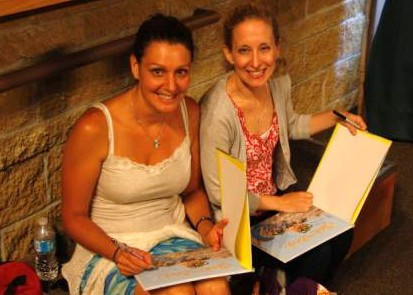
The Pinery is one of the few places in Canada where the Common Five-lined Skink can be found and it’s the area that inspired the character of Stewie and his story. There was something really special about reading Skink on the Brink right in Stewie’s natural habitat and then working with the kids on their terrific plasticine creations on the very veranda where he’s known to hang out and bask.
The kids at all of our events have been tons of fun to work with and incredibly excited – especially those who managed to catch a glimpse of a real Five-lined Skink in the wild, and Suzanne and I now both have households full of plasticine critters! But the best part is definitely hearing the kids’ enthusiasm for conservation efforts and for protecting skinks and their habitat.
------
For more interviews, see my Inkygirl Interview Archive.









